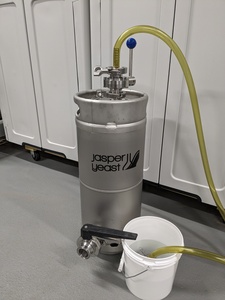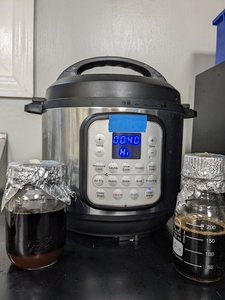Troubleshooting 101- slow or sluggish fermentation and the pH drop
It has been nearly 24 hours since you brewed and pitched your yeast, but you're still seeing few signs of active fermentation. Below is a list of what you should be testing, and options for speeding up active fermentation.
With the following tests and measurements, you should be able to accurately pinpoint the issue.
1. measure the gravity of the wort.
2.measure the pH of the wort.
3.perform a cell count
4. check the tank temperature vs. the set point.
Scenario #1
the gravity has not moved and the pH has also not moved. The cell count is half of what you expected to pitch, and the tank temperature is 3F below the set point.
Potential issue
Based on the readings, the yeast did not properly suspend itself in the wort and is slow to reach its growth phase. It's possible the brewer was casting out too warm, forcing the glycol jackets to cool the wort down to the fermentation set point. If the yeast strain is particularly flocculent, this early cooling could prevent the yeast from resuspending itself in the wort. This is often the case with lager fermentation, where the set point is low, and the glycol jackets are on too early in the growth stage.
Scenario #2
24hrs have passed and the tank is not actively fermenting, but the pH has dropped slightly. Temperature his holding steady at set point.
A drop in pH is a good indication of the early signs of fermentation for the following reasons;
Yeast consumes sugars (like maltose) in the wort as its energy source.
1. measure the gravity of the wort.
2.measure the pH of the wort.
3.perform a cell count
4. check the tank temperature vs. the set point.
Scenario #1
the gravity has not moved and the pH has also not moved. The cell count is half of what you expected to pitch, and the tank temperature is 3F below the set point.
Potential issue
Based on the readings, the yeast did not properly suspend itself in the wort and is slow to reach its growth phase. It's possible the brewer was casting out too warm, forcing the glycol jackets to cool the wort down to the fermentation set point. If the yeast strain is particularly flocculent, this early cooling could prevent the yeast from resuspending itself in the wort. This is often the case with lager fermentation, where the set point is low, and the glycol jackets are on too early in the growth stage.
Scenario #2
24hrs have passed and the tank is not actively fermenting, but the pH has dropped slightly. Temperature his holding steady at set point.
A drop in pH is a good indication of the early signs of fermentation for the following reasons;
Yeast consumes sugars (like maltose) in the wort as its energy source.
- During this process, yeast also produces various metabolites, including organic acids (like lactic acid and acetic acid).
These organic acids are acidic in nature, meaning they release hydrogen ions (H+) into the wort, lowering the overall pH.
- The more active the yeast is, the more sugars it consumes and the faster the pH drops.
2. Buffering Capacity Reduction:
Wort naturally contains various minerals and amino acids that act as buffers, resisting changes in pH.
As yeast metabolises these buffers along with sugars, the wort's overall buffering capacity decreases.
This makes the wort more susceptible to the acidifying effects of the aforementioned organic acids produced by yeast, further accelerating the pH drop.
Therefore, a steady and significant drop in pH within the expected range (around 0.5-1 unit in the first 24 hours) indicates that your yeast is actively fermenting and converting sugars into alcohol and other compounds.
Continue to monitor all variables. You can't take your hands off the steering wheel, but you should rest more comfortably knowing more active, visible fermentation with an accompanying drop in gravity will be measurable within 24hours after your pH drop. If you are consistently noticing a pH drop that takes more than 24hours, you might be underpitching the batch. Pull a sample and place in a warm room to ensure temperature is not an issue. We will dive into other ways pH is a crucial measurement in the brewing process, including mash, kettle, and terminal gravity pH.
Continue to monitor all variables. You can't take your hands off the steering wheel, but you should rest more comfortably knowing more active, visible fermentation with an accompanying drop in gravity will be measurable within 24hours after your pH drop. If you are consistently noticing a pH drop that takes more than 24hours, you might be underpitching the batch. Pull a sample and place in a warm room to ensure temperature is not an issue. We will dive into other ways pH is a crucial measurement in the brewing process, including mash, kettle, and terminal gravity pH.

Stay in the know
Sign up for our newsletter now and hop into the world of brewing excellence.
Related Posts

How to maintain high viability in stored yeast
2023-07-05 22:33:56 UTC
By: Travis Tedrow
Congrats! You have successfully harvested yeast into your brink. Now we will outline the best practices for feeding and storing your yeast to ensure the highest possible viability.

How to DIY your own Yeast Feeders
2023-08-08 04:17:11 UTC
By: Jasper Akerboom
We ship a small bottle of autoclaved media to feed yeast pitch for every order. Below we'll detail how you can make your own yeast feeders with wort from your kettle.
